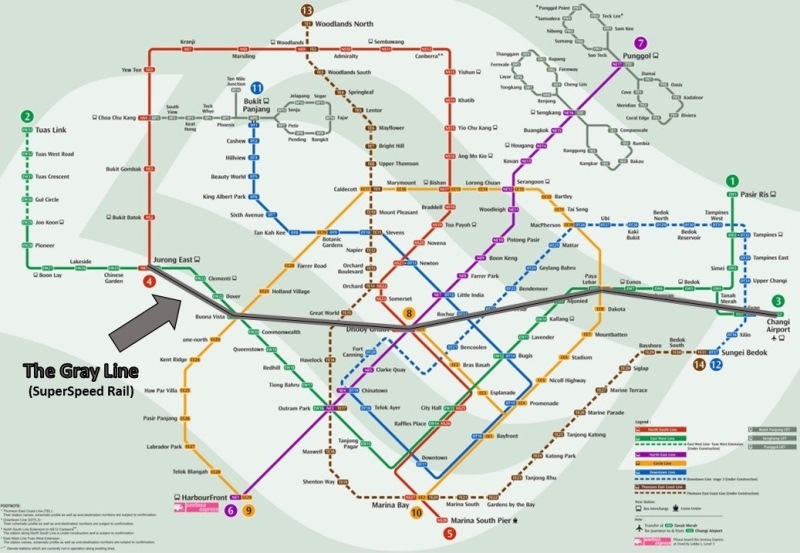
Here below is my joint paper submission with my co-author, Yeo Sunn Liang, for National University of Singapore, Lee Kuan Yew School of Public Policy‘s “Future Ready Singapore Project” essay competition.
Present(ing) Futures #2: The Future Of Mobility
What are the limitations and challenges of
Singapore’s transport model? And what reforms and
innovations do you think are required to overcome
those limitations and challenges, particularly in
terms of improving mobility for all?
Unfortunately the paper did not win, but here it is below; with permission from LKYSPP.
(Featured Image: Future Mobility Vehicle Concept for Singapore by Gemini)
———————————————————–
Share, green, speed: Making a case for a
comprehensive public transit, shared private vehicle ownership
and building a feasible bicycling culture in Singapore
Authors:
Herbert Sim, University of Wolverhampton, UK
Yeo Sunn Liang, Northumbria University, UK
November 2016
———————————————————–
Content
Abstract
Introduction
Focus on reliability
Superspeed rail
Roadblock to car ownerships
Car-light society
Going green
Conclusion
Bibliography
———————————————————–
Abstract
Singapore is small city with limited land for an expansive road network. To sustain our busy metropolis, an efficient system comprising of a reliable public transport, shared private vehicles for small businesses and the introduction of a bicycling culture is key to overcoming the limitations and challenges of Singapore’s current transport system.
The public transit system needs to be reliable with as few breakdowns on the MRT as possible, to instill public trust and form the spine of the public transit system. A Superspeed rail network that stops at key interchange stations can reduce congestion as well as travelling times. Public buses perform a support role to the MRT and offer first- and last-mile transport roles. To improve its service, buses need to offer reliable real-time arrival information that is accessible on mobile apps as well as at bus stops.
Sharing assets such as ETHOZCab rents cars to small businesses and entrepreneurs to provide private chauffeuring services via Uber and Grab, delivery services through CarPal, and other services. This keeps the car population down while maximising its use.
The government’s move to build a bicycling culture is to be applauded and can be improved by slowing traffic down closer to residences. Through building an efficient transport system, citizens will be more productive and enjoy better work-life balance.
Introduction
Land transport planning in Singapore can be challenging. The authorities have to carve up land for a growing population while maintaining an efficient traffic system. According to figures from the Singapore Department of Statistics, the total population has nearly doubled from 3 million in 1980 to 5.6 million in 2016. (Department of Statistics, Ministry of Trade & Industry, 2016) The rise in population naturally means a heavier toll on the land transport infrastructure.
Statistics from the Land Transport Authority (LTA) puts daily users of the Mass Rapid Transit (MRT) at 2.7 million in 2014, more than triple the 740,000 in 1995. (See Table 1. Data.gov.sg, 2016)
Table 1

(Data.gov.sg, 2015)
By 2030, the population in Singapore could grow to 6.9 million said the 2013 Population White Paper (National Population, and Talent Division, Prime Minister’s Office, 2013) stretching the transport system further. A more robust land transport system is needed to ferry Singapore’s growing population.
In this paper, we seek to discuss the reforms necessary to overcome the limitations and challenges facing Singapore’s current transport system.
Focus on reliability
Singapore’s MRT is the second-oldest metro system in Southeast Asia after the Manila LRT system. (Land Transport Authority, 2015b) In 2011, the smooth-running mass transit platform hit a roadblock.
Train operator SMRT reported three train breakdowns across two of its networks in the span of four days. The first occurred on the Circle Line, followed by two more hitches on the oldest North-South line. The disruptions affected an “estimated 500,000 commuters”. (Tan, 2011) Since then, the MRT as a whole had suffered multiple breakdowns – with 14 in 2015 alone – that had led to the public’s distrust of the rail system. Despite its failings, the LTA said the rail network’s reliability had improved. Trains travelled “an average of 133,000km before a delay of more than five minutes occurred” (in 2015) compared to 93,000km in 2014 and 58,000km in 2011, reported The Straits Times. (Tan, 2016)
To rebuild the public’s trust in the rail network, SMRT announced that it would sell its rail assets to the Singapore government. The LTA subsequently announced more capacity expansion and higher maintenance standards for SMRT rail from 2016, and “SMRT will pay a licence fee to operate the lines and earn revenue from them”. LTA will increase maintenance checks and audits as well as share profits and risks with SMRT. Commuter fares, which are regulated by the Public Transport Council, will not be affected, assured LTA. (Neo, 2016) SBS Transit is looking for a similar deal, as LTA said it is in discussion to transit the North-East Line and Sengkang-Punggol LRT to the New Rail Financing Framework (NRFF). (SBS Transit shares soar more than 10% on rail asset transfer talks with LTA, 2016) While the public remains skeptical, we believe this is a step in the right direction.
Superspeed rail
From as early as 1996, the LTA has outlined the MRT to be the main mode of transport to bring people in Singapore to their destinations in its landmark white paper. (Land Transport Authority, 1996) As of 2014, there were 154.2km of rail track (excluding the LRT) serving the needs of commuters. (Land Transport Authority, 2015a) The current travel time from Changi Airport to Jurong East stations takes about 60 minutes, according to the website MRT.sg.
This should be cut down. An express rail that stops at five major train interchange stations, Jurong East, Buona Vista, Dhoby Ghaut, Paya Lebar and Changi Airport will reduce travel time substantially.
The proposed Gray Line will halve travel time and ease congestion along the already burgeoning MRT networks. It will be even quicker than using a car, which is subject to prevailing road conditions. The proposed stops are strategically chosen to shave travelling time for all commuters. To illustrate, it will only take six stops instead of the usual 16 from Redhill to Changi Airport if the traveller would first travel back towards Buona Vista along the East-West line and continuing on the Gray Line. The express rail would be even more prudent when the rail network increases to 360km by 2030. (Land Transport Authority, 2016c)

(Photo above, created for illustration purposes – Herbert Sim, Yeo Sunn Liang, 2016)
The Superspeed rail will also cut a direct path from one international port of entry, Changi Airport, to another, the Jurong Lake District, where the proposed High Speed Rail between Singapore and Kuala Lumpur may be situated. Mentioned during the National Day Rally in 2014, the Jurong Lake District will become “a truly exciting gateway to Singapore”, said Prime Minister Lee Hsien Loong. (Yong, 2014)
A quicker commute will give Singaporeans a productive work life as well as a balanced family life. This fits into the aspiration of the Singapore Population White Paper to enhance work-life balance measures. (National Population, and Talent Division, Prime Minister’s Office, 2013)
Roadblock to car ownerships
Singapore’s limited land space means we can only have so many vehicles on the roads before we get into a gridlock. Since the 1970s, the government has introduced myriad ways to manage the car population. City planners sought to avoid gridlock through “fiscal disincentives such as import/excise duties (ID), Additional Registration Fees (ARF), road taxes”, and even to funnel traffic through Electronic Road Pricing (ERP) and its predecessor Area Licensing Scheme (ALS). (Fwa, 2016)
As of 2015, we have almost a million vehicles, including private cars, taxis, buses, goods and other vehicles as well as motorcycles (Land Transport Authority, 2016b) crammed onto 3,495km of roads including expressways, arterial roads, collector roads and local access roads. (Land Transport Authority, 2015a)
In 1990, a Select Committee made up of Members of Parliament concluded “the number of vehicles… must be controlled and limited below the level that a free market in vehicles would create”. The committee’s most significant contribution was its push for a quota system to control the vehicle population. (Fwa, 2016)
By issuing Certificates of Entitlement (COE) with a 10-year expiry for every on-road vehicle, planners were able to control the number of vehicles on the road. In 1998, a review stated the Vehicle Quota System (VQS) was effective in moderating vehicle growth to 3 percent, which allowed for infrastructure such as motorways to accommodate the increase. (Fwa, 2016)
Indeed, the measures to control the car population has helped keep the roads smooth. The average speed of traffic flow at the CBD (Central Business District) and arterial roads during peak hours has increased from 26.7km/h in 2005 to 28.9km/h in 2014. Traffic is also smoother on expressways. (Land Transport Authority, 2016d)
While the reduction of cars has kept our traffic smooth, it has caused considerable grumbling. There are valid reasons to car ownership, for example as viable transport options for ageing parents and young children when taxis are hard to come by. Certain occupations such as sales may also require copious amounts of travel. Maintaining the delicate balance of ownership versus its optimal use is addressed in our next section.
Car-light society
There are myriad factors behind buying a car such as work or family commitments. The sharing economy has also allowed car owners to earn side incomes on their down time.
Services such as Uber and GrabTaxi are giving taxi companies here a run for their money by marrying private car owners with public transportation. Despite official statistics, the on-ground sentiment is that there are not enough taxis. Even though taxis ply the road for fares, they are not around when you need one. Taxi drivers tend to go on breaks or are on “shift-change” due to the cab companies’ dual-shift policy.
One way to make traffic flow more efficient is to make call service free – just as Uber and Grab do through their apps. With free call-service, the public can be assured of a cab when they need one and taxi drivers can be directed to areas with high demand. Drivers may also choose to pick up fares that are on route when they go for their shift-change. The government should embrace companies such as Uber and Grab and allow taxi drivers to gain leverage through their booking systems.
There are more gaps in services that can be filled by taxi drivers or freelance Uber and Grab drivers that alleviate road use. CarPal matches logistics with freelance couriers to deliver small items for businesses such as fresh food suppliers, bakeries and florists. (Lim, 2016) Uber and Grab have also launched food delivery services as well as carpooling services that optimise car usage while keeping numbers low. Future applications could include health services such as private “ambulances” where a driver sends elderly passengers to and from their medical appointments. For an additional fee, drivers could wait with the patients at the clinics. This will allow caregivers time for themselves as well as peace of mind to focus on work.
Car sharing is another way to keep the vehicle population down. There are about 300 car-sharing services spread over 100 locations (One Motoring, 2016) that allow members to collect, use and return communal cars at public parking spaces such as mall and HDB carparks. Operators such as Car Club and WhizzCar have a fleet of cars for renters to choose from while iCarsClub match short-term renters with private car owners. ETHOZCab provides rental vehicles that allow the public to use as a personal transport as well as earn side income from Uber and Grab. These services are targeted at a large PMET demographic who cannot yet own personal vehicles but need one for their jobs, such as property agents.
Going green
The green movement has also made an impact on going car-less. Taking a cue from bicycling cities such as Copenhagen, the Singapore government and private enterprises could encourage bicycle use as a daily mode of transportation as a solution for the first-and-last-mile challenge, where travellers are required to travel from the MRT stations to their homes.
Today, a model “walking and cycling” town has been established at Ang Mo Kio. The four-kilometre network intersects the Ang Mo Kio MRT station, Ang Mo Kio Swimming Complex and AMK Hub, and will allow cyclists, motor vehicles and pedestrians to co-exist safely. By 2020, the cycling network will span 20km and connect Bishan-Ang Mo Kio Park and the Yio Chu Kang MRT station. (Land Transport Authority, 2016a) By 2030, all HDB towns will have a cycling network said LTA.
By reducing the emphasis on high-speed traffic by slowing traffic down and enforcing speed limits, as well as viewing streets as places to hold activities rather than as its access role, could make bicycling a feasible mode of daily transportation. It will also allow for a safer and more attractive urban environment. (Barter, 2005)
Conclusion
Singapore’s current transport system is limited by the space by which vehicular roads and expressways can be expanded. Yet public frustration at not being to own personal modes of transportation is palpable. This dissatisfaction stems from unhappiness over frequent breakdowns on the MRT.
As the public transit system becomes more consistent, the public will favour it as a more reliable mode of transport. The Superspeed rail will also cut travelling times and make public transit more appealing.
Even though LTA has kept traffic flow smooth through its car quota management system, there is still some needs for private car ownerships in Singapore. Using shared resources such as rental cars to fulfill logistics as well as the convenience of taxis, we can keep car numbers down and maximise productivity. The government should not curb the car-sharing economy but put policies in place to regulate practices while allowing it to flourish.
Building a sustainable and a green bicycling culture will make urban spaces cleaner and more conducive for families to play and interact in. Having a healthier nation in the process is a welcome side effect.
Singapore is a compact city with great urban planning and can be used as a role model of efficient infrastructure for future cities.
Bibliography
Barter, P. (2005) Changing Imperatives for Land Transport in Singapore: Challenges and Opportunities Looking Ahead towards 2020. Available at: http://lkyspp.nus.edu.sg/wp-content/uploads/2013/04/Policy-Seminar-LTA-talk-Barter.pdf (Accessed: 19 October 2016).
Data.gov.sg (2015) Public Transport Utilisation – Average Daily Public Transport Ridership. Available at: https://data.gov.sg/dataset/public-transport-utilisation-average-public-transport-ridership (Accessed: 19 October 2016).
Department of Statistics , Ministry of Trade & Industry (2016) ‘STATISTICS SINGAPORE – population trends 2016’, Population Trends 2016, , p. VI.Excerpt from Key Demographic Indicators, 1970 – 2016
Fwa, T.F. (ed.) (2016) 50 years of transportation in Singapore: Achievements and challenges. Singapore, Singapore: World Scientific Publishing Co Pte.
Land Transport Authority (1996) A world class land transport system (White Paper). Singapore: Land Transport Authority, Republic of Singapore.
Land Transport Authority (2015a) Statistics in brief 2015 FINAL. Available at: https://www.lta.gov.sg/content/dam/ltaweb/corp/PublicationsResearch/files/FactsandFigures/Statistics%20in%20Brief%202015%20FINAL.pdf (Accessed: 19 October 2016).
Land Transport Authority (2015b) Train Operators. Available at: https://www.lta.gov.sg/content/ltaweb/en/public-transport/mrt-and-lrt-trains/train-operators.html (Accessed: 19 October 2016).
Land Transport Authority (2016a) Ang Mo Kio: A model walking and cycling town. Available at: https://www.lta.gov.sg/content/ltaweb/en/walk-cycle-ride/integrating-cycling-with-public-transport/ang-mo-kio-model-walking-and-cycling-town.html (Accessed: 19 October 2016).
Land Transport Authority (2016b) Annual Vehicle Statistics 2016. Available at: https://www.lta.gov.sg/content/dam/ltaweb/corp/PublicationsResearch/files/FactsandFigures/MVP01-1_MVP_by_type.pdf (Accessed: 19 October 2016).
Land Transport Authority (2016c) MRT & LRT Trains. Available at: https://www.lta.gov.sg/content/ltaweb/en/public-transport/mrt-and-lrt-trains.html (Accessed: 19 October 2016).
Land Transport Authority (2016d) Traffic Flow. Available at: https://www.lta.gov.sg/content/dam/ltaweb/corp/PublicationsResearch/files/FactsandFigures/Traffic%20Flow.pdf (Accessed: 19 October 2016).
Lim, A. (2016) Local courier service nets $1m in funding. Available at: http://www.straitstimes.com/singapore/local-courier-service-nets-1m-in-funding (Accessed: 19 October 2016).
National Population, and Talent Division, Prime Minister’s Office (2013) A sustainable population for a dynamic Singapore: Population White Paper. Available at: http://www.nptd.gov.sg/portals/0/news/population-white-paper.pdf (Accessed: 19 October 2016).
Neo, C.C. (2016) LTA to buy SMRT assets for S$1 billion under new financing framework. Available at: http://www.todayonline.com/singapore/deal-reached-govt-take-over-smrts-rail-assets?cx_tag=similartd&cid=tg:recos:similartd:standard#cxrecs_s (Accessed: 19 October 2016).
One Motoring (2016) Car-Sharing. Available at: https://www.onemotoring.com.sg/content/onemotoring/en/lta_information_guidelines/car_sharing.html (Accessed: 19 October 2016).
SBS transit shares soar more than 10% on rail asset transfer talks with LTA (2016) Available at: http://www.straitstimes.com/business/companies-markets/sbs-transit-shares-soar-more-than-10-on-rail-asset-transfer-talks-with (Accessed: 19 October 2016).
Sharp, I. (2005) The journey: Singapore’s land transport story. Singapore, Singapore: Published for the Land Transport Authority by SNP Editions.
Tan, C. (2016) Rise in major breakdowns but MRT gets more reliable: LTA. Available at: http://www.straitstimes.com/singapore/transport/rise-in-major-breakdowns-but-mrt-gets-more-reliable-lta (Accessed: 19 October 2016).
Tan, W.H. (2011) Public anger mounts over SMRT train breakdowns in Singapore. Available at: http://www.digitaljournal.com/article/316245 (Accessed: 19 October 2016).
Yong, C. (2014) National day rally 2014: New Jurong lake gardens part of Lakeside transformation plans. Available at: http://www.straitstimes.com/singapore/national-day-rally-2014-new-jurong-lake-gardens-part-of-lakeside-transformation-plans-0 (Accessed: 4 November 2016).
———————————————————–

(Left to Right) Co-Authors of this paper, Yeo Sunn Liang and Herbert Sim
bandar togel
situs toto
prediksi hk
jacktoto
jacktoto
bandar togel
https://jacktotogacor.id/
penidabet
